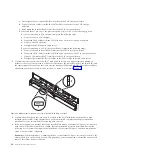
PCIe storage enclosures
Use this information to learn about connecting and configuring PCI Express (PCIe) storage enclosures to
system units.
Overview for PCIe storage enclosures
PCI Express (PCIe) storage enclosures provide additional storage capacity to the system in the form of
hard disk drives (HDDs) or solid-state drives (SSDs).
PCIe storage enclosures are connected to the system with PCIe cables. The PCIe cables extend the PCIe
buses that are generated by PCI host bridges in the system, and transport PCIe protocol information and
data between the system and the storage controllers in the PCIe storage enclosure.
Each PCIe cable connects to a PCIe connector on the system unit. The connector can be on a pluggable
card, such as a PCIe GX++ adapter, or can be mounted directly on the system unit chassis. In either case,
the connector is wired to a PCI host bridge that controls the PCIe protocol. The other end of the cable
connects to a PCIe connector on the PCIe storage enclosure that is wired to a storage controller in the
PCIe storage enclosure.
The PCIe interconnection between a system and a PCIe storage enclosure is point to point. Although a
PCIe storage enclosure is connected to the system unit with two PCIe cables, there is no redundancy or
cable failover capability in the PCIe links. However, access to all drives in the PCIe storage enclosure is
maintained in the event of a single PCIe link failure because of the dual controllers and fully redundant
SAS fabric within the PCIe storage enclosure.
Furthermore, there are multiple ways to connect the two PCIe cables from a PCIe storage enclosure to the
system, some of which result in a better high availability characteristics than others. For example,
connecting the two PCIe cables from a PCIe storage enclosure to different PCIe GX++ adapters in the
system creates a more highly available configuration than connecting the cables to the same PCIe GX++
adapter. If the PCIe GX++ adapters are in different processor drawers, such as is possible with
multi-drawer mid-range systems, such as 17M/MC and 79M/HC, the configuration is even more highly
available.
With proper software support in the operating systems, it is even possible to connect a PCIe storage
enclosure to two different systems for maximum high availability.
Important:
v
If additional PCIe GX++ adapters are needed to accommodate new PCIe storage enclosures, see the
instructions that came with the PCIe GX++ adapters for information about how to install them.
Installing PCIe GX++ adapters must be done separately from installing PCIe storage enclosures.
v
Before you change the system configuration, such as adding or removing PCIe storage enclosures, it is
a good practice to resolve all open serviceable events. If that is not possible, evaluate the open
serviceable events that cannot be resolved to determine whether or not they might interfere with the
procedure, and record them as evidence that they were not caused by the procedure.
77
Содержание Escala Power7 Series
Страница 1: ...Enclosures and expansion units ESCALA Power7 REFERENCE 86 A1 23FF 07 ...
Страница 2: ......
Страница 88: ...76 Enclosures and expansion units ...
Страница 146: ...134 Enclosures and expansion units ...
Страница 147: ......
Страница 148: ...Printed in USA ...






























